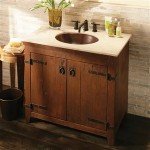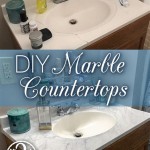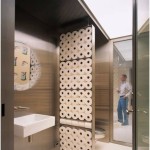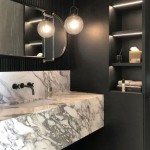White Bathroom Vanity With Drawers On Left: A Comprehensive Guide
The white bathroom vanity with drawers on the left presents a functional and aesthetically pleasing solution for optimizing bathroom storage and enhancing overall design. This configuration, characterized by a predominantly white finish and drawers situated on the left side of the unit, has gained considerable popularity due to its versatility, space-saving capabilities, and clean, modern appeal. Selecting the appropriate vanity involves careful consideration of various factors, encompassing size, material composition, style, and specific storage requirements. This article provides a detailed exploration of white bathroom vanities with drawers on the left, outlining their benefits, design considerations, material options, and practical implementation.
Benefits of a White Bathroom Vanity With Drawers On Left
Choosing a white bathroom vanity with drawers on the left offers a multitude of advantages that contribute to both the functional efficiency and visual appeal of a bathroom space. These benefits include space optimization, aesthetic versatility, and enhanced organization.
Space Optimization: The configuration of drawers on the left side can be particularly advantageous in bathrooms with specific spatial constraints. By positioning the drawers on the left, the adjacent space on the right often remains open or is better suited for accommodating plumbing fixtures or other bathroom elements. This asymmetry can maximize usable space, particularly in smaller bathrooms where every inch counts. The placement of the drawers ensures easy access to stored items without obstructing movement within the bathroom.
Aesthetic Versatility: White is a neutral color that seamlessly integrates with a wide range of bathroom design styles. From minimalist and contemporary to traditional and farmhouse aesthetics, a white vanity serves as a versatile foundation. It allows for easy coordination with other bathroom fixtures, tile colors, and decorative accessories. A white vanity also reflects light, making the bathroom appear brighter and more spacious. This inherent adaptability makes it a popular choice for both renovations and new construction projects.
Enhanced Organization: Drawers are inherently more efficient for organizing smaller items compared to cabinets. They allow for easy visibility and accessibility, eliminating the need to rummage through cluttered shelves. A vanity with drawers on the left typically features multiple drawers of varying sizes, providing ample space for storing toiletries, cosmetics, towels, and other bathroom essentials. The drawers can be further customized with dividers and organizers to maximize storage capacity and maintain a neat and orderly arrangement.
Design Considerations for White Bathroom Vanities
Selecting the right white bathroom vanity with drawers on the left requires careful evaluation of several design considerations. These include size and dimensions, style and design, and countertop material selection.
Size and Dimensions: Accurately measuring the available space is paramount. Consider the overall dimensions of the bathroom, the position of existing plumbing, and the desired amount of countertop space. Standard vanity heights typically range from 30 to 36 inches, while widths vary depending on the sink configuration and the overall dimensions of the bathroom. Opting for a vanity that is proportionate to the size of the bathroom ensures a balanced and harmonious aesthetic. A too-large vanity can overwhelm a small bathroom, while a too-small vanity may not provide sufficient storage space or countertop area.
Style and Design: White bathroom vanities are available in a wide range of styles, from sleek modern designs to more traditional and ornate options. Modern vanities often feature clean lines, minimalist hardware, and a focus on functionality. Traditional vanities, on the other hand, may incorporate decorative moldings, raised panel doors, and antique-inspired hardware. Selecting a style that complements the overall aesthetic of the bathroom is crucial. Consider the existing architectural details, color palette, and decorative elements when choosing the style of the vanity. The design of the drawers themselves can also vary, with options including flat-panel drawers, shaker-style drawers, and drawers with integrated pulls.
Countertop Material Selection: The countertop material significantly impacts the durability, aesthetics, and maintenance requirements of the vanity. Popular countertop options for white vanities include quartz, granite, marble, and solid surface materials. Quartz is a durable and low-maintenance option that is resistant to stains and scratches. Granite offers a natural stone appearance with unique variations in color and pattern. Marble is a luxurious option that adds elegance to the bathroom, but it requires more careful maintenance to prevent staining. Solid surface materials, such as Corian, are seamless and non-porous, making them easy to clean and maintain. The choice of countertop material should be based on both aesthetic preferences and practical considerations, such as budget, durability, and maintenance requirements.
Material Options and Construction
The materials used in the construction of a white bathroom vanity with drawers on the left significantly influence its durability, longevity, and overall aesthetic appeal. Common material options include solid wood, plywood, MDF (Medium-Density Fiberboard), and particleboard. Each material offers distinct advantages and disadvantages in terms of strength, moisture resistance, and cost.
Solid Wood: Solid wood vanities are known for their durability and natural beauty. They are resistant to warping and cracking and can withstand the humidity commonly found in bathrooms. However, solid wood vanities are typically more expensive than those made from other materials. Common wood species used in vanity construction include maple, oak, and birch. The wood can be stained or painted to achieve the desired white finish. Solid wood construction generally denotes higher quality and a longer lifespan for the vanity.
Plywood: Plywood is an engineered wood product made from layers of wood veneer glued together. It is more stable than solid wood and less prone to warping or cracking. Plywood is a good option for vanities that will be exposed to moisture. It offers a balance of durability and affordability. When selecting a plywood vanity, ensure that it is made with a water-resistant adhesive to prevent delamination.
MDF (Medium-Density Fiberboard): MDF is an engineered wood product made from wood fibers compressed together with resin. It is a smooth, uniform material that is easy to paint and finish. MDF is a more affordable option than solid wood or plywood, but it is less resistant to moisture. MDF is often used for the cabinet doors and drawer fronts of vanities, while the cabinet box may be made from plywood or particleboard. It's crucial to seal MDF properly to prevent moisture damage.
Particleboard: Particleboard is the least expensive material option for bathroom vanities. It is made from wood chips and resin pressed together. Particleboard is not very resistant to moisture and can swell and warp if exposed to water. Particleboard is typically used for the cabinet box of lower-end vanities. It is generally not recommended for bathrooms with high humidity levels.
The drawer construction also plays a crucial role in the overall quality and functionality of the vanity. Dovetail drawer boxes are considered the strongest and most durable option, as the interlocking joints provide exceptional strength. Other drawer construction methods include butt joints and doweled joints. The drawer slides should be smooth and durable, with options including soft-close slides that prevent slamming and extend the lifespan of the drawers.
Practical Implementation and Installation
The practical implementation of a white bathroom vanity with drawers on the left involves careful planning and execution to ensure a successful installation and optimal functionality. This includes considering the existing plumbing configuration, preparing the installation site, and following the manufacturer's instructions for installation.
Plumbing Considerations: Before purchasing a vanity, carefully assess the location of the existing plumbing lines for the sink and drain. Ensure that the vanity you select is compatible with the existing plumbing configuration. If necessary, consult with a plumber to make any necessary adjustments to the plumbing lines. It is also important to consider the location of the water shut-off valves, as they need to be accessible for maintenance and repairs. The drain placement must align with the sink's drain opening to prevent leaks and ensure proper drainage. The rough-in measurements for the plumbing are critical for a seamless installation.
Site Preparation: Preparing the installation site is crucial for a successful and hassle-free installation. Remove any existing vanities or fixtures from the area. Clean the floor and walls thoroughly. Check the floor for levelness and make any necessary adjustments to ensure that the vanity will sit evenly. If the floor is not level, use shims to level the vanity. Locate the wall studs and mark their positions, as the vanity will need to be securely attached to the studs. Turn off the water supply to the bathroom before beginning the installation process.
Installation Process: Follow the manufacturer's instructions carefully when installing the vanity. Typically, the installation process involves attaching the vanity to the wall studs using screws. Ensure that the vanity is level and plumb before tightening the screws. Connect the plumbing lines to the sink and drain, using Teflon tape to seal the connections and prevent leaks. Install the countertop and sink, following the manufacturer's instructions. Apply a bead of sealant around the edges of the countertop to prevent water damage. Connect the water supply lines to the faucet. Turn the water supply back on and check for leaks. Test the sink and drain to ensure that they are functioning properly. Finally, install the drawer pulls and handles.
Proper installation is paramount to the longevity and functionality of the vanity. If unsure about any aspect of the installation process, it is recommended to hire a professional plumber or contractor to ensure that the vanity is installed correctly and safely.

Bellaterra Home Com Bathroom Vanities Forli 37 In Single Vanity White Finish With Quartz And Round Sink Left Door

Diamond Now Cassidy 48 In Pearl Gray Single Sink Bathroom Vanity With White Cultured Marble Top The Vanities Tops Department At Com

Bellaterra Home 400700 37r 37 Single Sink Vanity In White Finish With Black Galaxy Granite And Left Oval Right Drawers Luxe Bathroom Vanities

35 Gloss White Free Standing Left Side Modern Bathroom Vanity China Unit Furniture Made In Com

Ptvsdb3021lapw By Allure Alma Painted White 30 X21 X34 75 Vanity With 2 Drawers On Left Studio41

V3021d L Dover White Vanity Base 1 Door 2 Drawers On Le Whole Cabinet Supply

Regent 36 White Oak Vanity Left Sink The Cabinet

Bridgeport 36 Teodor White Oak Vanity Left Sink Vanities

Elegant Left Bathroom Vanity Basin Sink Unit High Gloss White 1100x840x450mm

Yasinu 36 In W X 22 D Engineered Stone Composite Vanity Top White With Rectangular Single Sink On Left Size Yn2236lwh S The Home Depot
Related Posts







